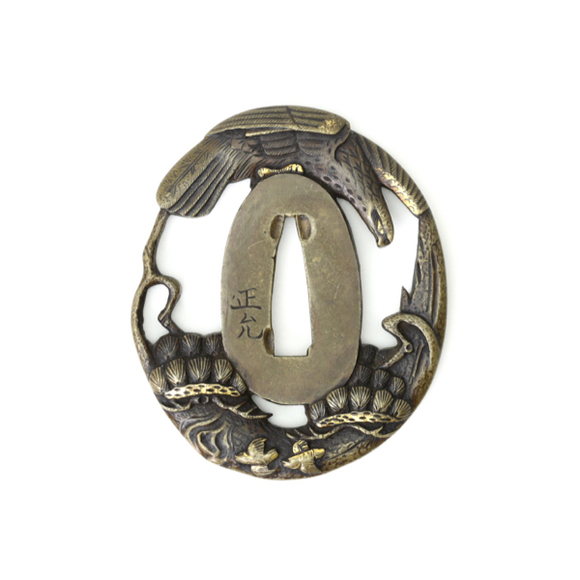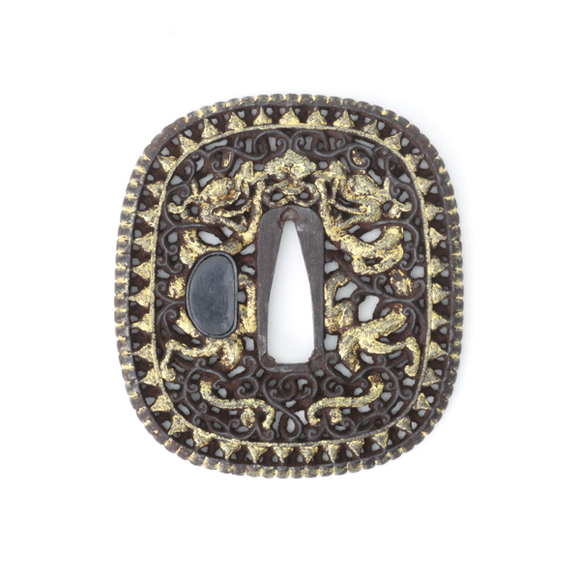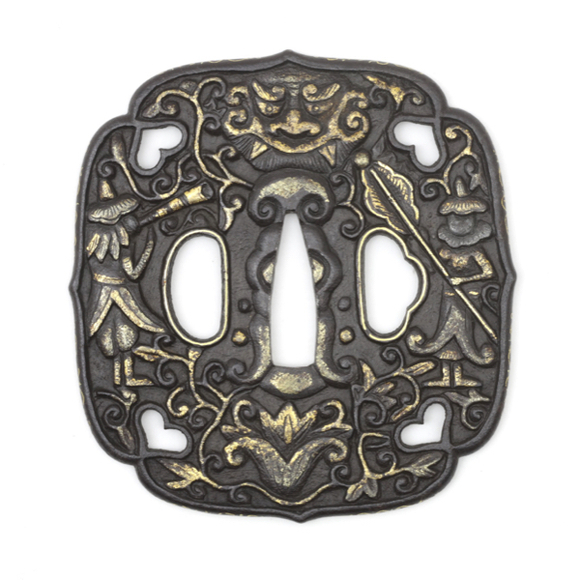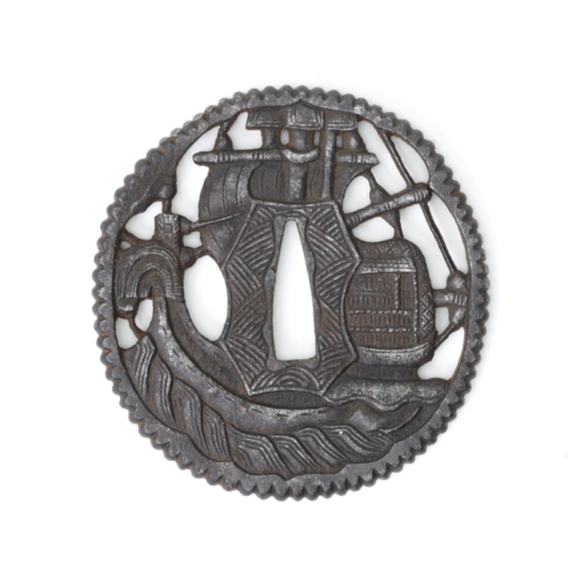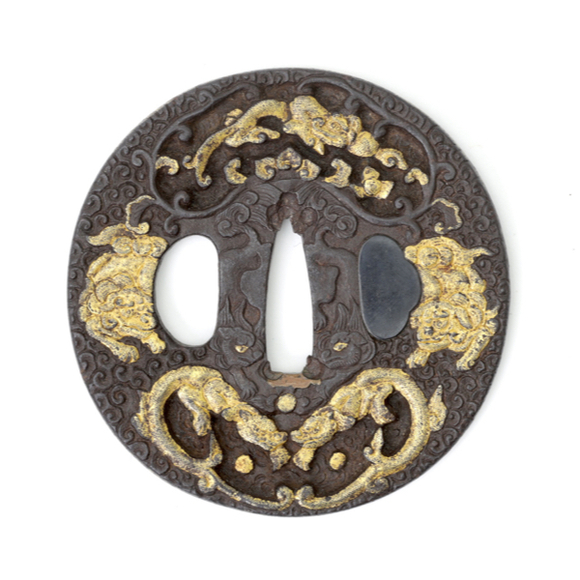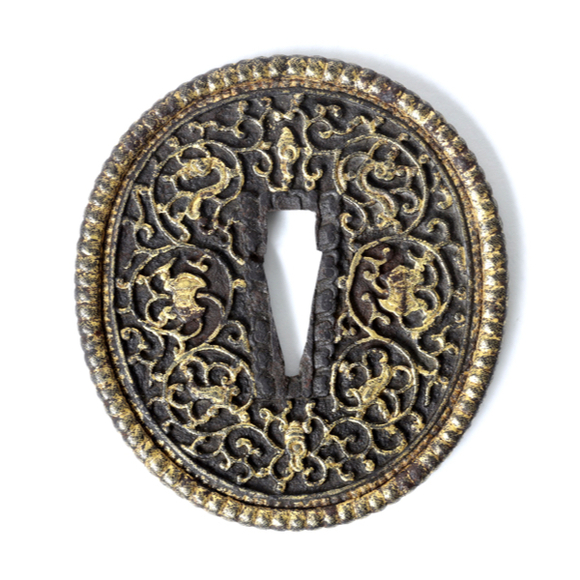Carved out of copper alloy with details highlighted in gold.

84.5 x 74.5 mm
8 mm thick
138 grams
Iron, shakudō, silver
Qing dynasty, China
Circa 1700 - 1750
Introduction
The Chinese saber guard is called dāo hùshǒu (刀護手), or hùshǒu pán (護手盤) in Qing dynasty Chinese sources. This literally translates to "saber handguard" or "disc handguard" respectively.
At some point, the Japanese got quite a taste for imported Chinese hùshǒu. Over the years a number of them have turned up from Japanese sources that exhibit alterations that indicate they were used by Japanese on their swords. The Japanese also started to produce their own guards with strong Chinese influence.
Japanese sword guards that exhibit any kind of foreign influence are today commonly called nanban tsuba by collectors and connoisseurs who are mostly unaware of the fact that some of these are not just foreign-influenced, but actually altogether foreign. Here is such an example.
Description
This iron sword guard of ovoid shape consists of two plates joined together on their flats, held by a rather thick rim of flattened oval cross-section. The seem between the plates can still be seen in the tang opening. The plate exposed at the back is left smooth, while the front plate is drilled and chiseled with ornamentation in the form of fine tendrils, and four characters in the lantsa script, an ornate form of writing Sanskrit.
The rim shows crosshatching with traces of silver overlay. The plate has a number of openings that I suspect once held semi-precious stones and/or corals, as seen on some high-end Qing arms primarily for the noble ranks.

The guard shown with the stones and corals it probably once had overlaid on the photo.
Color scheme is an educated guess.
The tang opening is cut so that the script is aligned with the edge pointing down, suited for the Qing way of carrying the saber edge-down, hilt backwards. Around the tang opening is not the usual oval washer seat that the Japanese tsuba would have, but instead the elongated trapezoid shape, following the shape of the angular ferrules that were popular in China primarily in the 17th and 18th centuries.
Japanese adjustments
An opening was cut to the lantsa character in the right. This opening is called kozuka hitsu ana in Japanese and serves to accomodate the kozuka, the hilt of a small utility knife that was often carried in the scabbard alongside the Japanese sword.
The opening was lined with shakudō, a Japanese alloy of gold and copper that was artificially patinated to a prized "raven black", making the metal resemble lacquerwork.
On the plain side of the guard, one can vaguely make out the contours of an oval Japanese washer, called seppa, that were used as spacers to ensure a tight fit, indicating prolonged use of the guard on a katana or wakizashi.
Lantsa script and its significance
Each of the lantsa letters represents a syllable. The first is oṃ, the all encompassing sound and the start of most Buddhist mantras. The letter on the right is mostly removed by the addition of the hitsu-ana, but in all likelyhood reads ā. Read from top, right, left, it forms the well-known mantra:
oṃ ā hūṃ
This mantra is frequently explained as signifying the trinity of body, sound and spirit.
The letter on the bottom is not part of the mantra, in fact, there are no four letter mantras. It possibly reads hā which means "to speak, is spoken".1 It may serve in a way to automate the mantra, much like the spinning of prayer wheels with mantras on them.
Many Manchus and Mongols were Tibetan Buddhists and Helmets with mantras in lantsa script were worn by the Kangxi and Qianlong emperors, and from the late 18th century onwards also by high ranking military officials.2 Mantras seen on helmets worn by the Qianlong emperor and his military officials include oṃ maṇi padme hūṃ and the oṃ ā hūṃ seen on this guard.

Qing helmets with lantsa script.
Left: a painting of the Qianlong emperor by Giuseppe Castiglione.
Right: A high ranking Qing dynasty officer's helmet in the Metropolitan Museum of Art, New York.
Accession number: 36.25.5a.
Dating and attribution
Pierced ironwork of the early Qing primarily consisted of bold scrollwork with larger openings between the elements. By the 18th century, designs got increasingly fine but also more cramped. In the late 18th century, pierced iron got mostly replaced by copper alloys that could be worked into greater detail, and were subsequently gilt. So going by materials, technique, and style, it is fairly safe to say that this guard probably dates from the first half of the 18th century.
Pierced iron mounts that held (semi-)precious stones and corals were not just for anybody. In fact, they were reserved only for the higher noble ranks of the early Qing.3

Portrait of Manchu general Mingliyang, Marquis of the first rank, hero of the First Jinchuan Campaign of 1747-1749.
Notice the use of iron mounts, his armor embellished with corals, turquoises and lapis lazuli.
(His full title in Manchu translates as: "Assistant Commander to the Right (wing) of the Border Protection Forces,
Commander of Chengdu, Marquis of the first rank, with the designation Hero of Merit, Mingliyang")
Conclusion
A Chinese saber guard with decor in pierced iron, showing a mantra that was commonly used on imperial helmets. Style, workmanship, and materials place it in the first half of the 18th century. The guard has a number of bezels that probably once held (semi-)precious stones and / or coral. Such embellishment was only reserved for the higher princely ranks.
The full saber this piece was made for must have been spectacular when new, with a full set of scabbard mounts, ferrule and pommel all done in the same style.
We can only guess as to how a guard of this quality made it to Japan, but signs of prolonged use indicate it was cherished by its overseas owner.
A remarkable and unusual piece.
Notes
1. Thanks to Juul Eijk, education and research staff member, Leiden University, for help with the lantsa script. Any and all errors are still my own.
2. The 1766 Huangchao liqi tushi (皇朝禮器圖式) still only lists such helmets for imperial use, but subsequent editions of the Daqing Huidian (大清會典) show a trickle down effect of these helmets into the upper echelons of military ranks as well. This explains why the Metropolitan Museum's example does not have imperial golden yellow, but black flaps that were among others worn by the rank of general.
3. Ibid. These texts give a clear overview on which embellishments were for whom, and weapons with stones set in them are only described in use for the emperor, imperial guards during auspicious ceremonies, and various princely ranks.




Unusual tsuba with foreign figures and Chinese auspicious symbols.
With the swirling arabesque motifs that are typical for this period.

